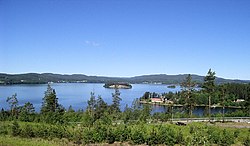Ångerman
| Ångerman | |
|---|---|
 | |
 | |
| Native name | Ångermanälven (Swedish) |
| Location | |
| Country | Sweden |
| Physical characteristics | |
| Mouth | Gulf of Bothnia |
• coordinates | 62°48′N 17°56′E / 62.800°N 17.933°E |
• elevation | 0 m (0 ft) |
| Length | 460 km (290 mi)[1] |
| Basin size | 31,864.0 km2 (12,302.8 sq mi)[2] |
| Discharge | |
| • average | 500 m3/s (18,000 cu ft/s)[1] |
The Ångerman or Angerman (Swedish: Ångermanälven) is one of Sweden's longest rivers with a total length of 460 kilometers (290 mi). It also has the third largest flow rate, after the Göta and Lule.
Name
[edit]The name was formerly written Ångermann or Angermann.[3] The name is derived from the Old Norse anger, which means "deep fjord" and appear as such in placenames in Norway and as "ånger" in placenames along the coast of Norrland.[citation needed]
Course
[edit]It starts in the Scandinavian mountain range in the southern parts of the Swedish province of Lapland. It then trails through Jämtland, increasing in power in the province of Ångermanland, whose name derives from it. The Vojmån, Fjällsjö, and Fax are its main tributaries. It contains an internal bifurcation Vängelälven.
It is navigable for about 50 miles (80 km) from the sea.[3] Over the last 30 kilometers (20 mi) (after the town of Sollefteå noted on the map), it flows through a scenic valley known as Ådalen. The Ångerman then empties into the Baltic Sea's Gulf of Bothnia near the town of Kramfors.
References
[edit]Citations
[edit]Bibliography
[edit]- , Encyclopædia Britannica, 9th ed., Vol. II, New York: Charles Scribner's Sons, 1878, p. 29.
- "Ångermanälven", Nationalencyklopedin, retrieved 11 July 2010. (subscription required) (in Swedish)
- "Län och huvudavrinningsområden i Sverige" (PDF), SMHI, Swedish Meteorological and Hydrological Institute, retrieved 11 July 2010. (in Swedish)
